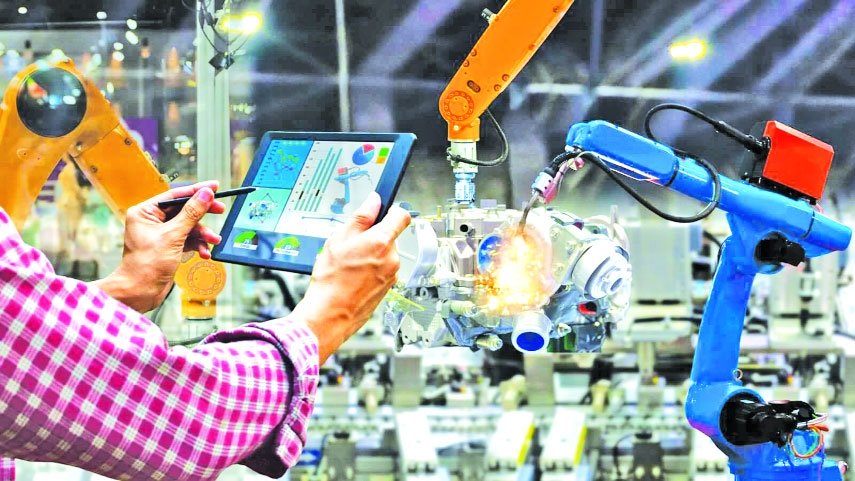Published: 08:26 AM, 26 November 2025 Last Update: 08:44 AM, 26 November 2025
Bangladesh’s Next Leap: Rising as South Asia’s Regional Manufacturing Powerhouse

Shahidul Alam Swapan
For decades, Bangladesh occupied a modest place in the global economic conversation, often framed by its challenges rather than its ambitions. But that narrative has shifted dramatically. Today, Bangladesh stands at a pivotal moment, emerging as one of the most compelling manufacturing growth stories in Asia. With rapid industrialization, a young workforce, infrastructure upgrades, and a strategic geographic position, the country is preparing to take on a larger role as a regional manufacturing powerhouse. As global supply chains diversify beyond traditional hubs like China, Bangladesh’s rise feels not only possible but increasingly probable.
The transformation did not happen overnight. Bangladesh’s manufacturing journey began with the ready-made garment (RMG) sector, which has grown into the world’s second-largest apparel exporter after China. The sector’s success has been built on competitive labor costs, improving compliance standards, and an ecosystem of suppliers, entrepreneurs, and skilled workers who have consistently raised the bar. But the future of Bangladesh’s manufacturing strength goes well beyond garments. The country is moving toward diversified industrialization, with sectors like electronics assembly, pharmaceuticals, leather goods, light engineering, and automotive components gaining traction. Government-backed export processing zones and special economic zones have attracted investment from Japan, China, South Korea, and Europe, signaling confidence in Bangladesh’s long-term industrial potential.
One of Bangladesh’s greatest advantages is its demographic dividend. More than half of the population is under the age of 35, offering a steady supply of energetic, trainable workers eager to enter manufacturing. Unlike many countries facing aging populations, Bangladesh stands at an enviable intersection of youth and ambition. This demographic advantage, paired with rising literacy rates and improvements in technical education, forms a strong foundation for industrial expansion. Increasingly, vocational training centers and public-private partnerships are developing the skills required for higher-value manufacturing, ensuring that Bangladesh’s workforce can adapt to global industry standards.
Infrastructure—once one of Bangladesh’s biggest obstacles is undergoing a visible transformation. The opening of the Padma Bridge, expansion of the Dhaka-Chattogram highway, construction of new ports, and introduction of mass transit systems such as the metro rail are reshaping internal connectivity. These improvements matter enormously for manufacturers who rely on predictable logistics and efficient supply chains. The upcoming deep-sea port at Matarbari promises to significantly reduce shipping costs and timelines, positioning Bangladesh as a more competitive option for global buyers. Investors who once hesitated due to infrastructure bottlenecks are beginning to see an emerging environment of reliability and modernization.
But what truly strengthens Bangladesh’s case is the shifting landscape of global sourcing. As multinational companies rethink their reliance on a single manufacturing hub, Bangladesh has become one of the most attractive alternatives. Concerns over geopolitical tensions, rising wages in China, and the need for supply chain resilience have driven buyers to explore new destinations. Bangladesh’s proven capacity, competitive labor market, and expanding industrial infrastructure make it a natural choice. The country has already benefited from the “China Plus One” strategy and stands poised to absorb more shifts as global manufacturing continues to diversify.
However, Bangladesh’s journey toward regional manufacturing power status is not without challenges. The country must confront energy shortages, bureaucratic delays, and the need for deeper reforms in trade logistics and financial systems. Power instability continues to disrupt factories, particularly those relying on energy-intensive machinery. Addressing this requires long-term planning in renewable energy expansion, liquefied natural gas infrastructure, and grid modernization. Additionally, improving customs efficiency and export procedures will help shorten lead times, a critical factor in competitive manufacturing.
The environmental dimension is equally important. As the world moves toward sustainable production, Bangladesh must adopt greener technologies to remain relevant. Many global buyers now require carbon footprint disclosures, waste management systems, and eco-friendly materials. Encouragingly, Bangladesh leads the world in the number of green RMG factories certified by the US Green Building Council. If this momentum extends to other industries, sustainability could become a competitive edge rather than a hurdle. In my opinion, the future success of Bangladesh as a regional manufacturing powerhouse depends on embracing diversification, innovation, and resilience. The country cannot rely on garments alone. Investments in automation, artificial intelligence, and digital manufacturing will shape the next era of competitiveness. Rather than fearing automation, Bangladesh should prepare its workforce for more sophisticated roles that accompany technological upgrades. Global manufacturers will increasingly gravitate toward countries capable of blending human skill with digital precision, and Bangladesh needs to be part of that conversation.
Regional cooperation will also play a vital role. Strengthening trade relationships with India, Nepal, Bhutan, and Southeast Asian economies can open new supply chains and markets. Bangladesh’s strategic location—bridging South Asia, Southeast Asia, and maritime routes—gives it a natural advantage. With better connectivity and harmonized trade policies, the country can position itself as a hub linking regional production networks.
Equally crucial is fostering a culture of entrepreneurship and industrial innovation. Local manufacturers must be encouraged to move up the value chain, develop proprietary products, and innovate beyond contract manufacturing. Government incentives, easier access to finance, and technology transfer programs will be key in nurturing homegrown manufacturing champions. If Bangladesh can create an ecosystem where small and medium enterprises (SMEs) scale into global suppliers, its manufacturing identity will become more sustainable and diversified.
Social stability and worker welfare remain vital to maintaining Bangladesh’s global reputation. As international scrutiny grows, the country must ensure safe working conditions, fair wages, and strong labor rights. A stable, satisfied workforce is not only morally essential but economically strategic. Buyers prefer sourcing from countries where compliance risks are minimal, and Bangladesh has made visible progress in this area. Sustaining that momentum will cement its place as a dependable manufacturing partner.
Despite the hurdles, the optimism surrounding Bangladesh’s future is well-earned. The nation has repeatedly shown that it can defy expectations through resilience and determination. From recovering swiftly after global recessions to navigating supply chain disruptions, Bangladesh’s manufacturing sector has demonstrated remarkable adaptability. This resilience is one of the clearest indicators that the country is ready for its next leap.
Bangladesh is no longer simply an emerging competitor—it’s becoming a central player in global manufacturing. With a proactive approach, visionary planning, and sustained investments in skills, technology, and infrastructure, the country has the potential to become South Asia’s manufacturing engine. The next decade will be defining. If Bangladesh successfully harnesses its current momentum, it will not just participate in global manufacturing it will lead, shape, and redefine it.
The world is watching, and Bangladesh is rising.
Shahidul Alam Swapan is a
private financial crime specialist
and an author based in Switzerland.



